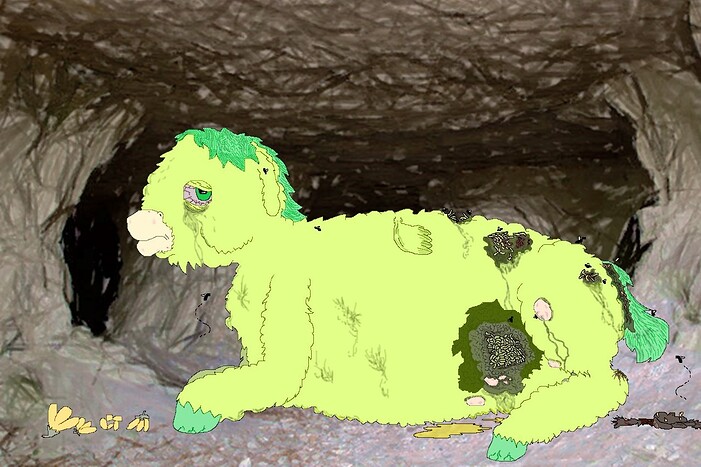Feral fluffy mares face a grim and inevitable fate once they begin the process of continuous birthing, a task their genetically-engineered biology compels them to repeat over and over during the warmer months of the year. These mares, driven by their need to find a nest and give birth to multiple litters, ultimately become immobile due to their overwhelming physical demands. As their bodies weaken and become fixed in place, their survival becomes contingent on the care of their “special friends” and occasionally their rejected foals—who may assist in rudimentary cleaning. However, this is not nearly enough to stave off the disaster that lies ahead.
Without proper care and in the unsanitary conditions of the wild, these mares become beacons of disease and decay. Their constrained lifestyle and poor hygiene, combined with their inability to properly manage defecation and urination, create a breeding ground for serious bacterial infections, skin diseases, and viral afflictions. Their already fragile biology is woefully unsuited for survival outside the controlled environments in which they were initially engineered.
As a result, most feral fluffy mares experience a rapid decline in health. The heat of the summer, coupled with the physical strain of pregnancy and birth, exacerbates the deterioration of their bodies. The cycle of infection and biological breakdown worsens as the mare’s body becomes encrusted with waste and filth, leading to open sores, infections, and internal damage. By late summer, these mares are often in critical condition, and without intervention, they rarely survive past early fall or winter.
In this particular case, we see a feral mare who is still being tended to by her special friend. Unfortunately, this effort is tragically misguided. The food her companion brings—a simple field flower—offers no real nutritional value to a mare in desperate need of vitamins, minerals, and proteins essential for survival and raising her foals. While fluffies are naturally attracted to pretty objects, this instinct works against them in this context, as they are biologically incapable of recognizing what their bodies truly need to survive.
Without proper nutrients, this mare’s fate is sealed. Her body, already ravaged by infections and decay, is simply too far gone. The lack of sustenance and the harsh realities of her life in the wild have created a hellish scenario that is, unfortunately, all too common among feral fluffies.
By the age of four years, this mare is near death. She, like many mares, has chosen to attempt to leave her parents home in an effort to have her own family. This is now the result of such an action. Her once fluffy and vibrant exterior is now mottled with rot and infection, her body wasting away while she remains tethered to her nest. This tragic pattern of fluffy mares succumbing to their biological needs and environmental pressures is seen worldwide, particularly in regions where fluffies have escaped into the wild.
Without proper caretakers, feral mares endure short lives full of pain, disease, and inevitable death. Their existence serves as a stark reminder of the dangers of genetically-engineered creatures left to survive in an environment they were never meant to thrive in. For most feral fluffy mares, their life ends not in the embrace of family or friends, but in the lonely decay of a nest they will never leave.
